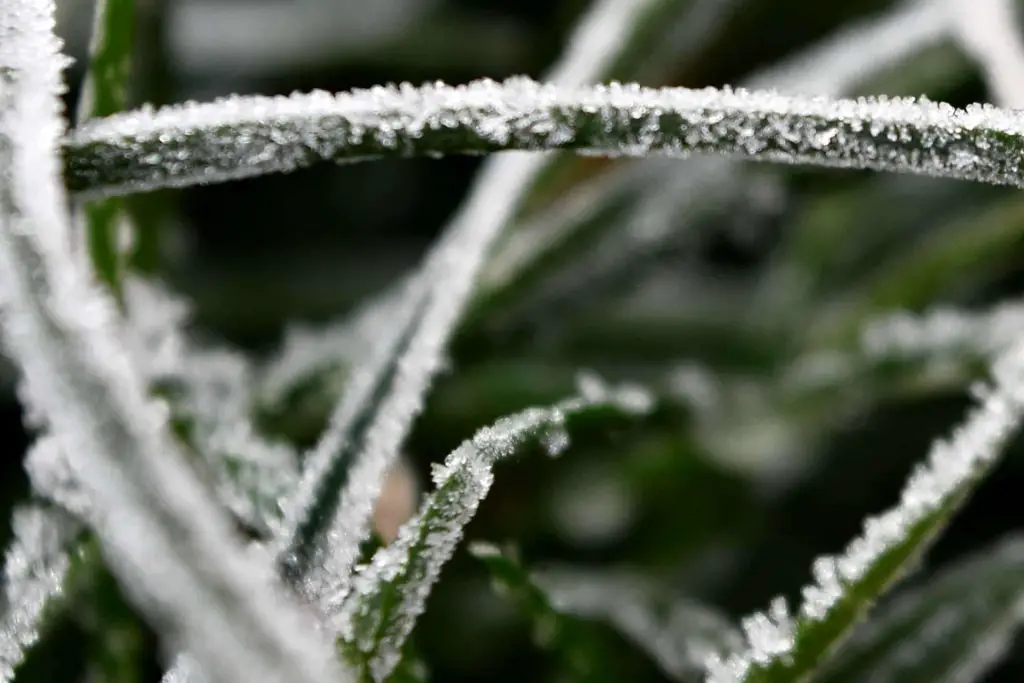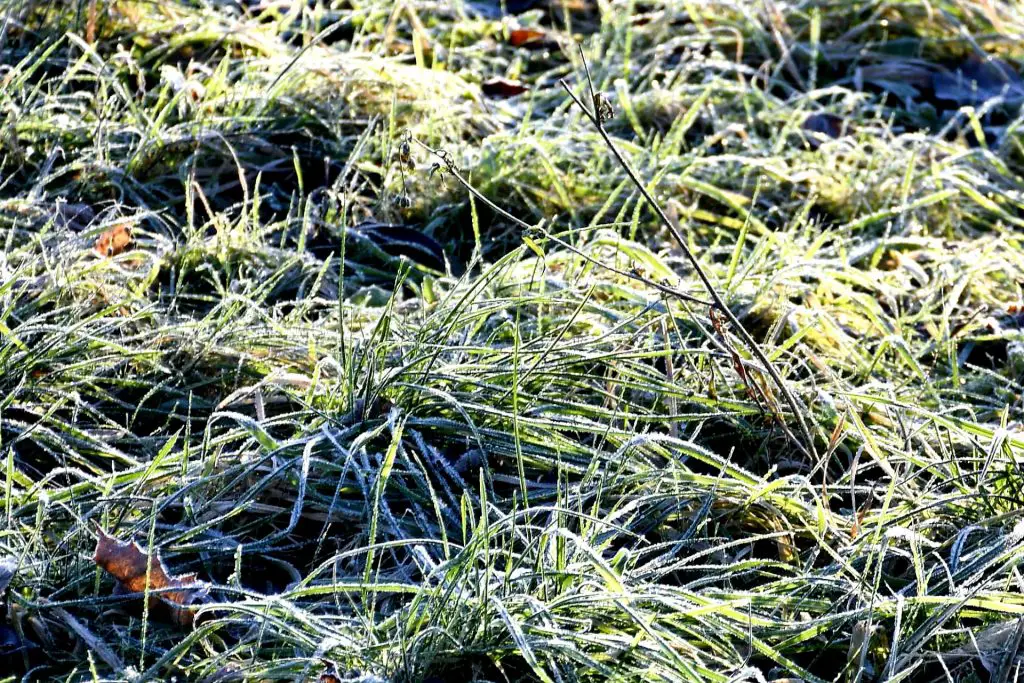When is it Too Cold to Fertilize a Lawn? – What Temperature is Too Low?
We all aim to have a beautiful green grass lawn and most gardeners know that a proper lawn care program that includes fertilizing is the best way to achieve this. However, there are times of the year when it is too cold to fertilize, and doing so can possibly cause more harm than good.
There are a number of factors to take into consideration when applying fertilizer in cold weather, these range from differences between cool-season and warm-season grasses, the air temperature, and the soil temperature, we will look at each of these and assess how they impact the best time to fertilize.
You should only fertilize a lawn when the grass roots are active. However, this varies depending upon whether you have warm or cool season grass. With cool-season grasses, their roots can remain active until heavy frosts set in. In general, though, you shouldn’t fertilize your lawn if the temperature drops below 50°F.
Cold Weather and Your Lawn’s Fertilizer Schedule

As the weather gets colder you need to think more carefully about the fertilizer schedule for your lawn. There is a little bit of misinformation relating to when and when not to fertilize, particularly around when you start to see frosts.
Frost and Your Lawn
When you apply fertilizer during the winter months if the ground has yet to freeze, it will be absorbed by the roots of your grass. The fertilizer will then be available for use throughout the growing season.
As long as the soil isn’t frozen, grass root systems remain active. As a consequence, fertilizing in many locations can still be worth doing until around the middle to end of November. Even if you see frost and your grass has stopped growing, your plants may still use nutrients since the soil is unlikely to have frozen at that moment.
However, if you don’t fertilize your lawn until after regular heavy frosts occur, then fertilizer may not be able to penetrate the frozen ground. This could cause your lawn to look yellow or brown, the result of the fertilizer remaining on the grass blades too long and burning them. If this happens, wait until warmer weather before fertilizing again.
How Temperature Effects Your Schedule
Cold weather can have a negative effect on your lawn’s fertilizer schedule. Lawns are composed of either cool-season grasses or warm-season grasses, and each type has different fertilizer needs. Cool-season grasses go dormant in late spring, when the air temperature starts to warm up and the soil temperature begins to rise.
Warm-season grasses, on the other hand, are more active during the late spring and summer months. This increased temperature stimulates root growth in warm season grass, so fertilizing during this time helps the grass to develop a strong, healthy root system. They don’t begin to go dormant until the air temperature starts to cool down in the fall.
Here’s what you need to know about applying fertilizer in cold weather.


As the temperatures start to cool off in the fall, it’s important to adjust your lawn care routine. The type of grass you have (cool-season or warm-season) will dictate when you need to start making changes. For cool-season grasses, you should start seeing a decline in growth in late spring as the soil temperature starts to cool off.
This is the time to start reducing your fertilizer applications for cool-season grass. The amount of nitrogen in your fertilizer should be reduced by half. You can do this by using a less nitrogen-rich fertilizer. For warm-season grasses, like Bermuda and zoysia, growth will decline in late summer as the air temperature cools off. These grasses will go dormant from late fall depending on temperature.
At what temperature is it too cold to fertilize a lawn?
There are a few things you can do to keep your lawn healthy during the winter months. First, you need to know what type of grass you have. Cool-season grasses like bluegrass, ryegrass, and fescue are the most common in the US. Warm-season grasses like bermudagrass, zoysiagrass, and St. Augustinegrass are common in the southern US.
If you have a cool-season grass, as we have mentioned, they will go dormant in the late spring when the air temperature gets too warm. The root growth will stop, but the shoot growth will continue. This is why it’s important to fertilize your lawn in the early spring or late fall.
On the other hand, warm-season grasses like bermudagrass, zoysiagrass, and centipedegrass should be fertilized in late spring or early summer as they go dormant as the temperature drops in late summer and early fall.
Most manufacturers list that soil temperature should be at least 60°F for fertilizer to be effective but usually it will work down to 50°F and below. The roots of your grass are growing and the grass is actively growing at this temperature, they stop growing at around 41°F. If the temperature drops below this point it is too cold, the fertilizer will not be absorbed by the roots and the grass will not benefit from the treatment.
The consequences of fertilizing a lawn in cold weather.
Applying fertilizer to cool-season grasses in late spring can actually hinder root growth because the soil temperature is too cold. This type of grass is better suited to fertilizer applications in late fall or early winter.
For warm-season grasses, it’s best to wait until late spring or early summer to apply fertilizer, when the air temperature is warm and the grass is actively growing. Most lawn fertilizers are rich in nitrogen, which helps promote shoot growth.
Application Rates
In general, you should apply 1 pound of nitrogen per 1,000 square feet of lawn and during periods of active growth, you may need to increase the amount of nitrogen you apply to 2-3 pounds per 1,000 square foot. it is important to read the fertilizer label to determine how much nitrogen is present.
Nitrogen-rich fertilizers will need less fertilizer applied. You can determine the amount of nitrogen from the three numbers printed in the fertilizer bag the NPK. The first value indicates the percentage of nitrogen in the fertilizer. If the numbers are 10-10-10, a ten-pound bag contains one pound of nitrogen; nevertheless, if the digits are 21-22-4, a ten-pound bag has 2.41 pounds of nitrogen.
However, different types of grass require different amounts of fertilizer. For example, cool-season grasses such as bluegrass, fescues, and ryegrass need about 1 pound of nitrogen per 1000 square feet of lawn. Warm-season grass such as bermudagrass, zoysias, and St. Augustine requires about 3 pounds of nitrogen per 1000 square feet. Of course, you’ll also need to consider how much water your lawn requires. A well-watered lawn will use less fertilizer than one that receives little rainfall.
When to Apply Fertilizer


As we have mentioned you should look to apply fertilizer before the first strong frost. In areas where there is no chance of freezing temperatures, you can adjust your application accordingly. For places that experience freezing temperatures, apply fertilizer just before the first heavy frost or as soon as the ground thaws out after the last snowfall.
When the soil freezes, the nutrients become locked into the soil particles. It takes several weeks for these nutrients to break down and release back into the soil. By applying fertilizer before the first hard freeze, you ensure that all of the nutrients are available to the grass once the soil thaws again.
If you’re using a granular slow-release form of fertilizer, it will release the nutrients over a period of time and provide a more regulated source of nitrogen to the ground. If you feel the lawn needs a nitrogen boost, add grass clippings as an alternative option.
Another factor that should be taken into consideration is foot traffic and soil compaction. The more traffic your lawn has during the summer months can lead to increased soil compaction making it more difficult for the nutrients in the fertilizer to travel down to the grass roots. This is why it is often a good time to fertilize after aerating, which is often carried out in the fall and before the ground freezes.
Taking Into Account Your Lawns Growth Cycles
The best time to fertilize your lawn is when the growth stage of your grass is most active. When this is will depend on the type and variety of grass you have. If you live in a temperate climate you are likely to have cool-season grass and in hotter climates warm-season grass. As we have seen the distinction is important because their growth cycles differ.
As such, when applying fertilizer in cold weather, it is important to know the difference between cool-season and warm-season grasses. Cool-season grasses grow best in late spring when the air temperature is cool and the soil temperature is warm. Warm-season grasses grow best in the summer when the air and soil temperatures are hot.
Mixed Grass Types
There are some areas where it is common to have mixed warm and cool season grasses. This adds another variable to the mix and you will have to look and observe your lawn to work out what the ‘peak’ growing season is and fertilize accordingly.
Summary: What Temperature Is Too Cold to Fertilize a Lawn?
The type of grass you have will determine when you should fertilize your lawn. If you have cool-season grass, you should fertilize in late spring when the root growth is active. If you have warm-season grass, you should fertilize in late spring or early summer when the shoot growth is active.
As we have seen it is important to coincide you’re fertilizing schedule with the growing season of your lawn. For warm-season grasses, you would be looking to fertilize in the spring, after the frosts have broken. For cool-season grasses either late autumn or early spring is the time to fertilize before the heavy frosts have set in and after the frosts have broken.
The key point to remember is that fertilizing your lawn when the grass is dormant will just result in the fertilizer being wasted. Always follow the manufactures instructions and ensure that the daytime temperatures are at least above 50°F and you should end up with a healthy lawn.
